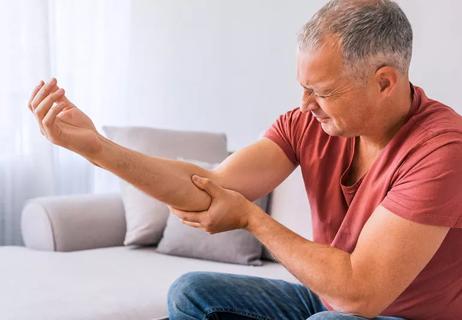What to know before seeking medical attention

Pain is your body’s way of telling you something is wrong. But it doesn’t always tell you exactly what’s wrong and if you need medical treatment. So, when pain develops in your hand, wrist or elbow, how do you know whether to treat it at home or see a doctor?
Advertisement
Cleveland Clinic is a non-profit academic medical center. Advertising on our site helps support our mission. We do not endorse non-Cleveland Clinic products or services. Policy
Orthopaedic surgeon William Seitz, Jr., MD, who specializes in upper extremity problems, explains what to look for when experiencing these pains and when you’ll need to contact a healthcare provider for extra attention.
In some cases, the reason for your pain is obvious — maybe you’ve worked in the garden for several hours or had a bad fall. In others, pain seems to come out of the blue.
“You may develop pain from infection, inflammation or an underlying metabolic issue like gout or diabetes-related neuropathy,” Dr. Seitz says. “Also, the pain may be unrelated to your arm — for example, a pinched nerve in the neck can cause pain anywhere throughout the arm.”
Your activity level and the wear and tear on your body can also factor in, especially with joint pain or various forms of tendinitis. If you’re highly active, you can typically expect some pain in your joints as you get older.
“Mileage plays a role,” notes Dr. Seitz. However, you shouldn’t expect pain just because you’re aging — it may never develop.
Certain activities or conditions can make you more prone to experiencing elbow and wrist pain. The list includes:
While you can get golfer’s elbow from plenty of things other than golf — tennis, hammering and working out — the pain is still the same. The repeated bending, grasping and twisting of your arm and wrist can cause inflammation in the tendons that connect your elbow to your forearm. That can lead to pain that radiates to your little and ring fingers, most commonly by irritation of the ulnar nerve on the inner side of your elbow.
Advertisement
Carpal tunnel syndrome is a condition directly affecting the hand and wrist. It occurs when repeated finger and hand use — like working an assembly line or repetitive hammering — causes swelling about your wrist. That puts pressure on the median nerve and tendons that run through the “tunnel” between your hand and forearm, leading to pain, weakness, tingling and even numbness in your hand and wrist.
Arthritis is another possibility, as it’s common for types of arthritis to affect the fingers and hand. Two types of arthritis, in particular, are common culprits of this kind of joint pain: osteoarthritis and rheumatoid arthritis. Osteoarthritis is more common and caused by wear and tear on your joints, breaking down cartilage in your joints over time. Rheumatoid arthritis is a chronic autoimmune condition in which an overactive immune system causes inflammation and, ultimately, cartilage degeneration in your joints.
Muscle strains and ligament sprains are yet another cause of pain, and they can frequently happen in your thumb, finger and wrist, leading to pain throughout your whole hand. Sprains are usually the result of an injury, stretching or tearing ligaments within a joint. Chances are, you’ll be able to recognize it after a fall or accident, but you’ll want to check with a healthcare provider to make sure there aren’t any fractures.
Some other causes of elbow, wrist or hand pain include:
Even if you can’t quite figure out if your pain is from one of these conditions, there are still things you can do to narrow it down and get proper treatment.
Health professionals determine which people need urgent medical care using a process known as triage. You can apply the same technique at home.
Dr. Seitz says if something is seriously wrong, you’ll know it. A wrist fracture, for instance, will cause pain you can’t ignore. “When the pain is so bad you can’t move past it, call your doctor or head to the emergency department,” he advises.
If you don’t have that level of pain, then listen to your body. Take a moment to consider why you might be feeling pain and what it can tell you. Dr. Seitz suggests asking yourself these questions to decide what to do for your hand, wrist or elbow pain:
Advertisement
“If your answers to the first three questions are “yes,” or if your pain level is in the upper half of the pain scale (6 through 10), then it’s time to call the doctor,” says Dr. Seitz. “If you answer “no” to the first three questions and rate your pain at a 1 through 3, you can start with treatment at home.”
If your symptoms aren’t serious, start by reducing the pain. Dr. Seitz suggests the following steps:
If you can tie your pain to overexertion, or if you think it stems from repetitive motion (such as tennis elbow), take a break from that activity. Give your body a rest.
Even tolerable pain may signal a more serious problem when it persists. If home treatment doesn’t seem to address the issue after two or three days, contact a doctor.
Provide as much information as possible about your activities and other pertinent factors, including which medications or supplements you’re taking.
Your doctor will help identify the problem, even if it’s an underlying issue causing the persistent pain.
Advertisement
“Most processes that aren’t worrisome tend to run their course in a few days,” Dr. Seitz says. “Acute symptoms — such as severe swelling, redness, pain or deformity — may need more urgent evaluation and care.”
Ultimately, taking a few minutes to assess your pain may help you avoid an emergency room visit for situations that aren’t serious.
Advertisement
Learn more about our editorial process.
Advertisement

Plus, exercises and movements to avoid

Learn how this simple piece of equipment can help relieve elbow pain

Remedies and new options for tennis elbow

Your knees could be hurting at bedtime because of inflammation, injury or some other condition that gets worse with pressure and positioning

Looking down at your smartphone or computer screen can stress muscles in your neck, shoulders and back

Hanging upside down for any length of time may decompress the tension in your spine

Stretches, exercises and posture changes can help address lower cross syndrome

These creams that you apply to your skin can actually help reduce localized pain, swelling and inflammation

Leg-related symptoms indicate DVT, while chest symptoms point to a pulmonary embolism

There are many different ways to love someone and yourself

Looking down at your smartphone or computer screen can stress muscles in your neck, shoulders and back